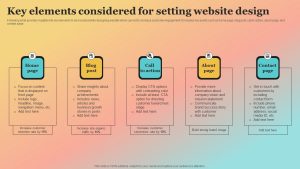Key Strategies for Website Branding
Website branding plays a crucial role in establishing your business’s identity, building trust with customers, and differentiating you from your competitors. In today’s digital world, a well-designed website that effectively communicates your brand’s message is one of the most important tools at your disposal. To achieve this, you need to focus on creating a cohesive and engaging experience for your visitors. In this article, we will explore key strategies for website branding that can help you build a strong, recognizable, and successful online presence.
1. Understand Your Brand Identity
Before you start designing your website, it’s essential to clearly define your brand identity. Your brand is more than just your logo or colors; it encompasses your mission, values, and the emotions you want to evoke in your audience. Understanding your brand’s identity ensures that every element of your website is aligned with your business’s purpose and message.
Define Your Brand’s Mission and Values
Ask yourself the following questions to understand your brand’s identity:
What problem does your business solve?
What are your core values?
What do you want customers to feel when they interact with your brand?
These answers should guide all decisions related to your website, from the design to the content you present. For example, a brand that emphasizes sustainability will have a different website aesthetic than one that focuses on luxury or innovation.
Create a Unique Value Proposition
Your unique value proposition (UVP) is the reason why customers should choose your business over competitors. It should be prominently displayed on your website’s homepage, clearly communicating why your brand stands out. Whether it’s affordability, quality, or exceptional customer service, your UVP should resonate with your target audience.
2. Consistency Across All Touchpoints
Consistency is key in branding, and this applies to your website as well. Your website should mirror your brand’s visual identity and tone of voice across all other marketing channels. Whether it’s your social media, packaging, or advertisements, your brand should be easily recognizable and offer a consistent experience.

Visual Consistency
Your website’s design elements, such as colors, typography, and imagery, should reflect your brand’s established identity. Use your brand’s primary colors consistently throughout your website. For example, if your brand uses blue and white as its primary colors, ensure these shades dominate your website’s design.
Typography also plays a significant role in conveying your brand’s personality. A formal brand may choose a serif font, while a modern or tech-focused brand may opt for sans-serif fonts.
Voice and Tone Consistency
Your brand’s tone of voice should remain consistent throughout your website’s content. This includes everything from your homepage copy to your blog posts and product descriptions. If your brand is friendly and approachable, ensure that your content reflects this tone.
For example, a financial services website may use professional and formal language, while a lifestyle brand may opt for casual and conversational language.
3. Prioritize User Experience (UX) Design
User experience (UX) design is crucial to website branding. A website that is easy to navigate and provides a positive experience encourages visitors to engage with your brand longer. In fact, studies show that a well-designed website can increase conversions and sales.
Mobile-Friendly Design
With more users accessing websites from their mobile devices, having a mobile-friendly design is no longer optional. Ensure that your website is responsive, meaning it adapts to various screen sizes without compromising functionality or aesthetics. A mobile-optimized website is essential for maintaining a positive user experience across all devices.
Intuitive Navigation
Your website’s navigation should be intuitive and easy to use. Visitors should be able to find the information they need quickly without feeling lost or frustrated. Organize your content into clear categories and use straightforward labels for your menu items.
A well-structured website with clear navigation will make it easier for users to discover your products or services, ultimately improving your branding.
Fast Loading Speeds
Site speed is another crucial factor in the overall user experience. Slow loading times can frustrate visitors, causing them to abandon your website before they even have a chance to engage with your content. A fast-loading website is a reflection of a brand that cares about providing a high-quality experience.

4. Create Compelling Content
Content is one of the most powerful tools in your website branding strategy. Your content should not only reflect your brand’s voice and values but also provide value to your audience. Well-crafted content can establish your brand as an authority in your industry and build trust with your customers.
Craft Engaging Copy
Every word on your website should serve a purpose. The copy should be engaging, informative, and aligned with your brand’s identity. Highlight key selling points, share success stories, and incorporate calls to action that guide users toward taking the next step in their customer journey.
Remember that your content should be clear, concise, and easy to read. Use short paragraphs, bullet points, and subheadings to make your content scannable.
Incorporate Visual Content
Images, videos, and infographics are essential components of effective website branding. Visual content helps to break up text, making your website more visually appealing and engaging. High-quality images that align with your brand’s aesthetic can also strengthen your visual identity.
For example, if your brand is focused on eco-friendly products, you may want to feature images of nature, sustainable practices, or happy customers using your products.
5. Leverage Social Proof
Social proof is a powerful tool for building credibility and trust with your website visitors. Displaying customer reviews, testimonials, or case studies can help validate your brand’s claims and demonstrate that others have had positive experiences with your business.
Showcase Customer Testimonials
Feature testimonials from satisfied customers on your homepage, product pages, or landing pages. Positive reviews can significantly influence purchasing decisions, as they provide social proof that your products or services are effective and valuable.
Display Industry Awards and Certifications
If your business has received industry awards or holds certifications, showcase these on your website. This helps build trust with potential customers by demonstrating that your brand is recognized and reputable.
6. Optimize for Search Engines (SEO)
An effective website branding strategy goes hand-in-hand with strong SEO practices. Your website needs to be easily discoverable by your target audience through search engines. Search engine optimization (SEO) helps improve your site’s visibility, which can lead to more traffic and higher engagement.
Incorporate Target Keywords
To optimize your website for search engines, use relevant keywords that your target audience is likely to search for. Incorporate these keywords naturally into your website’s content, including headings, body text, meta descriptions, and image alt texts.
Improve Site Structure
Ensure that your website has a clear and logical structure. A well-organized website with internal linking can help search engines crawl and index your site more efficiently, ultimately boosting your SEO performance.
Conclusion
Effective website branding requires a clear understanding of your brand identity, consistency across all touchpoints, a strong focus on user experience, compelling content, and a strategic approach to SEO. By incorporating these key strategies, you can create a website that not only reflects your brand but also drives engagement, builds trust, and helps you achieve your business goals. Whether you’re starting from scratch or looking to revamp an existing site, focusing on these elements will set you on the path to success in the digital world.





